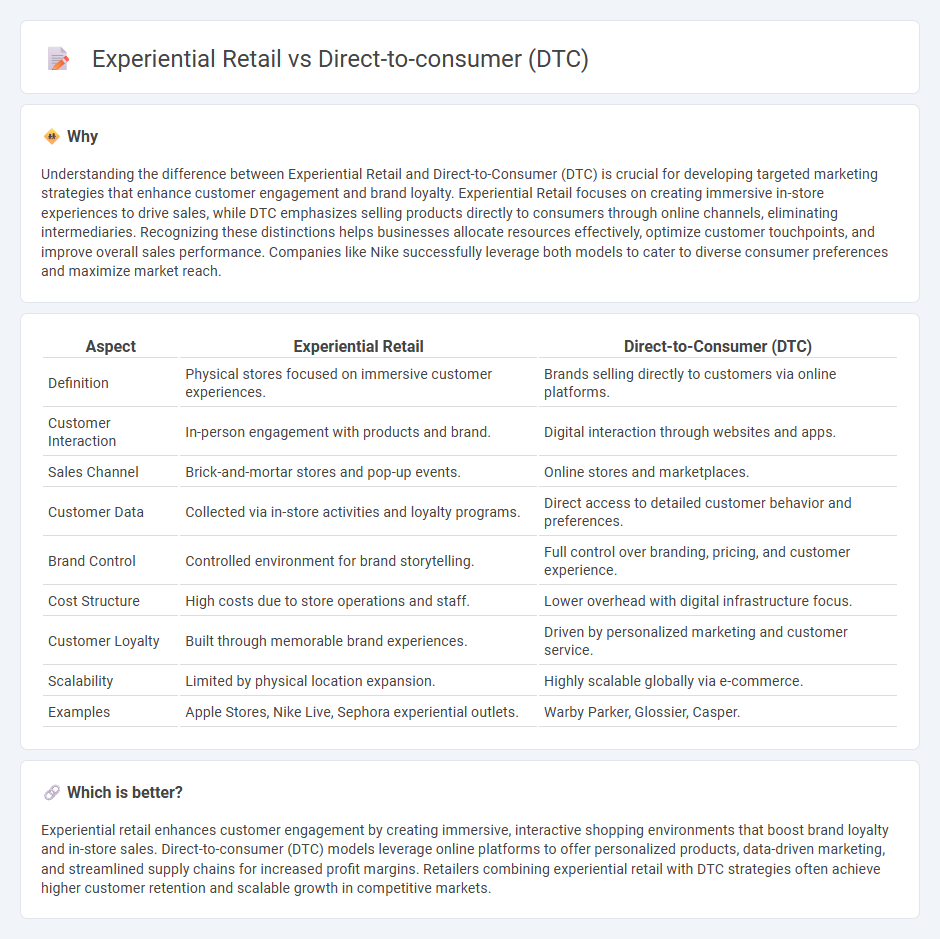
Experiential retail enhances customer engagement through immersive in-store experiences that blend entertainment, personalized service, and technology, driving brand loyalty and higher foot traffic. Direct-to-consumer (DTC) business models focus on selling products directly via online platforms, offering greater control over brand messaging and customer data while reducing reliance on traditional retail channels. Explore the benefits and challenges of both approaches to understand how they shape the future of retail strategies.
Why it is important
Understanding the difference between Experiential Retail and Direct-to-Consumer (DTC) is crucial for developing targeted marketing strategies that enhance customer engagement and brand loyalty. Experiential Retail focuses on creating immersive in-store experiences to drive sales, while DTC emphasizes selling products directly to consumers through online channels, eliminating intermediaries. Recognizing these distinctions helps businesses allocate resources effectively, optimize customer touchpoints, and improve overall sales performance. Companies like Nike successfully leverage both models to cater to diverse consumer preferences and maximize market reach.
Comparison Table
| Aspect | Experiential Retail | Direct-to-Consumer (DTC) |
|---|---|---|
| Definition | Physical stores focused on immersive customer experiences. | Brands selling directly to customers via online platforms. |
| Customer Interaction | In-person engagement with products and brand. | Digital interaction through websites and apps. |
| Sales Channel | Brick-and-mortar stores and pop-up events. | Online stores and marketplaces. |
| Customer Data | Collected via in-store activities and loyalty programs. | Direct access to detailed customer behavior and preferences. |
| Brand Control | Controlled environment for brand storytelling. | Full control over branding, pricing, and customer experience. |
| Cost Structure | High costs due to store operations and staff. | Lower overhead with digital infrastructure focus. |
| Customer Loyalty | Built through memorable brand experiences. | Driven by personalized marketing and customer service. |
| Scalability | Limited by physical location expansion. | Highly scalable globally via e-commerce. |
| Examples | Apple Stores, Nike Live, Sephora experiential outlets. | Warby Parker, Glossier, Casper. |
Which is better?
Experiential retail enhances customer engagement by creating immersive, interactive shopping environments that boost brand loyalty and in-store sales. Direct-to-consumer (DTC) models leverage online platforms to offer personalized products, data-driven marketing, and streamlined supply chains for increased profit margins. Retailers combining experiential retail with DTC strategies often achieve higher customer retention and scalable growth in competitive markets.
Connection
Experiential retail enhances Direct-to-consumer (DTC) strategies by creating immersive, interactive shopping environments that deepen customer engagement and brand loyalty. Both approaches emphasize personalized experiences and transparent customer relationships, enabling brands to gather valuable first-party data for targeted marketing. The integration of experiential retail within DTC models drives higher conversion rates and fosters long-term consumer trust through direct interaction.
Key Terms
Brand Ownership
Direct-to-consumer (DTC) models empower brands to control every aspect of the customer journey, enhancing brand ownership through direct engagement, personalized offerings, and data-driven insights. Experiential retail elevates brand ownership by creating immersive, sensory-rich environments that foster deeper emotional connections and customer loyalty. Explore how these strategies redefine brand ownership and impact consumer behavior.
Omnichannel Engagement
Direct-to-consumer (DTC) brands leverage personalized online platforms to streamline purchasing processes and gather customer data, enhancing targeted marketing efforts. Experiential retail combines physical store interactions with digital touchpoints, creating immersive environments that boost customer engagement and brand loyalty through sensory experiences. Explore the strategies each model employs to maximize omnichannel engagement and drive consumer satisfaction.
In-Store Immersion
Direct-to-consumer (DTC) brands increasingly leverage experiential retail to create immersive in-store environments that deepen customer engagement and strengthen brand loyalty. In-store immersion techniques such as interactive displays, personalized consultations, and sensory experiences transform traditional shopping into memorable events that drive higher conversion rates. Explore how integrating DTC models with experiential retail can redefine customer experience and boost sales.
Source and External Links
Direct to Consumer (DTC) Sales: Tips and Examples to Sell More - Direct-to-consumer (DTC) is a model where brands or manufacturers sell their products directly to customers, bypassing third-party retailers, which allows more control over branding, customer data, and higher profit margins.
Direct-to-consumer - Wikipedia - DTC (or D2C) is a business model selling products directly to consumers, often online, bypassing wholesalers and retailers, and has grown significantly with examples like Allbirds, Glossier, and Warby Parker.
The Ultimate Guide to Direct To Consumer (DTC) - Brightpearl - DTC is a sales channel strategy that shifts manufacturers or consumer packaged goods brands away from traditional distribution by selling directly to consumers, enabled by e-commerce platforms that lower barriers to entry.
 dowidth.com
dowidth.com